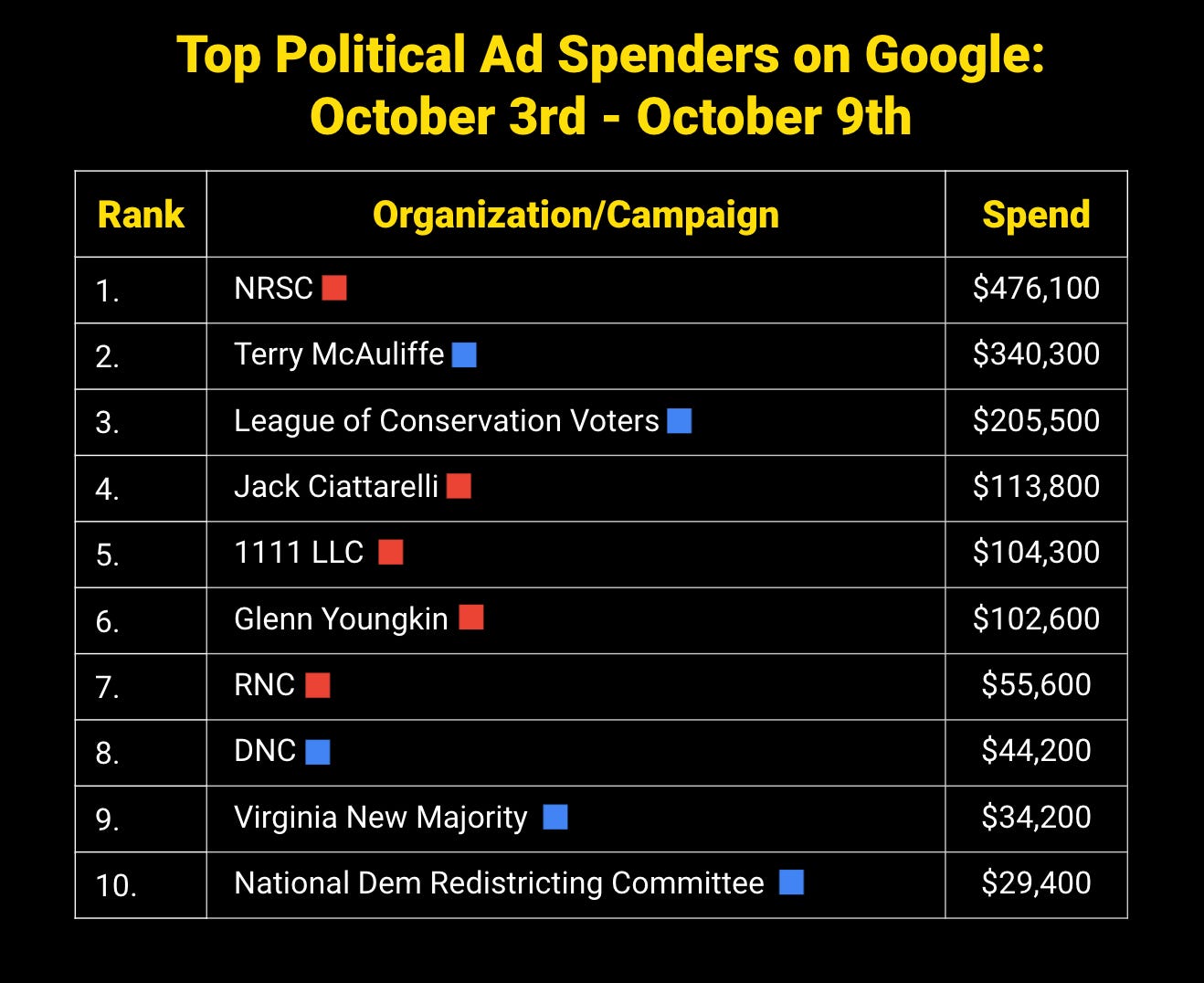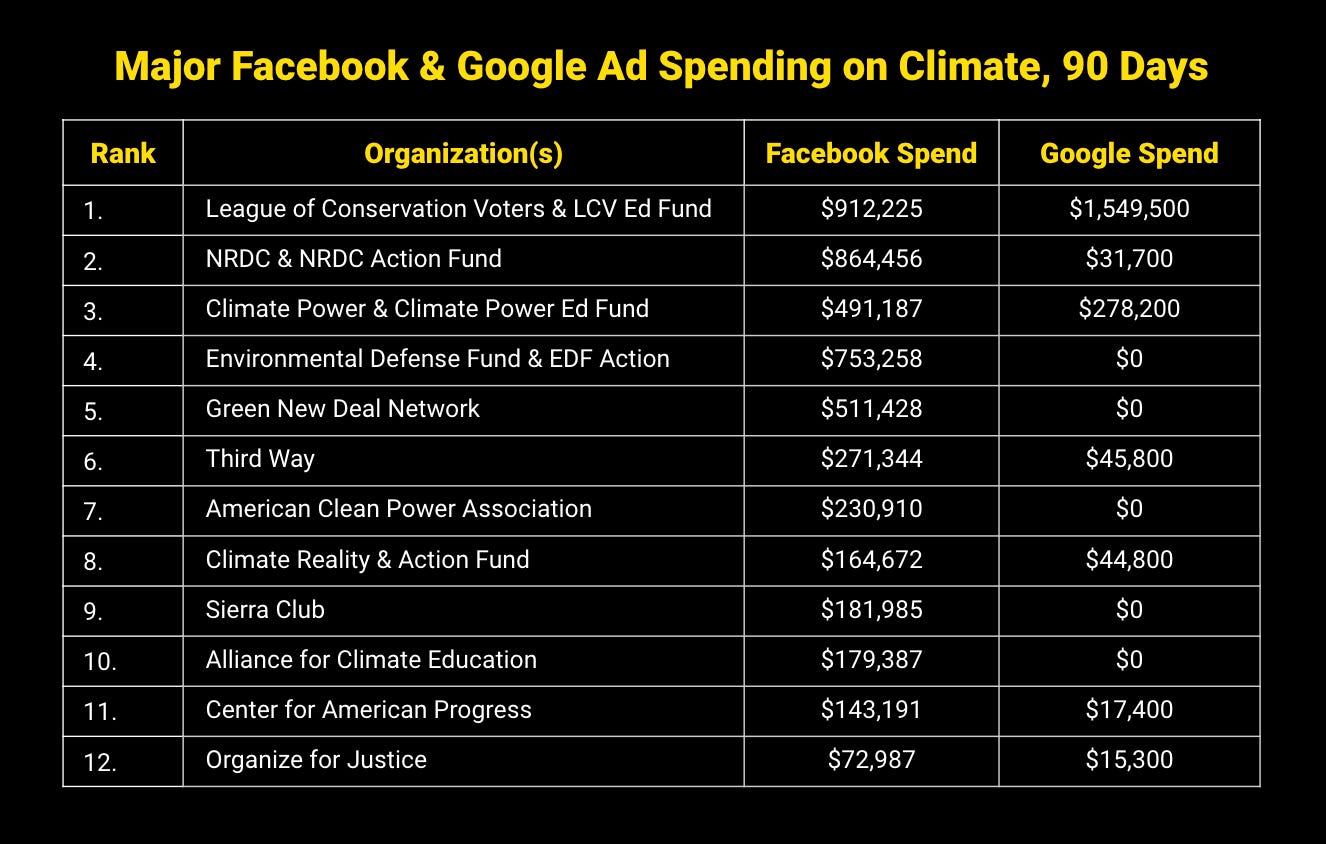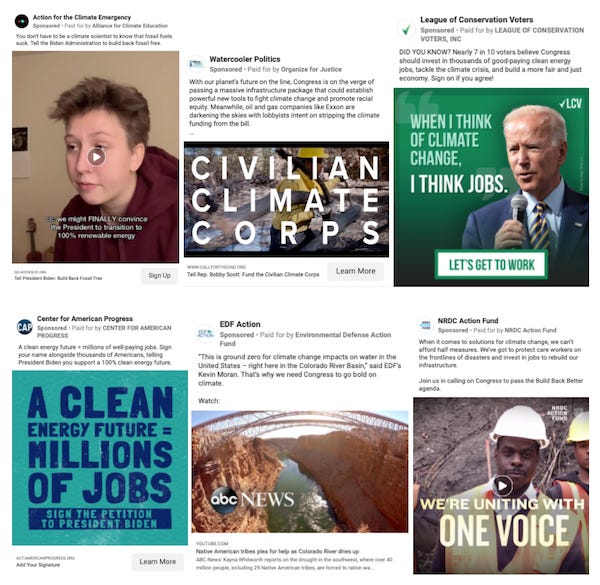Inside the largest pro-climate ad campaign in history
Outside groups have spent millions on our last best chance to tackle climate change in Congress. Will it be enough?
Over the past three months, more Americans have seen advertising about climate change than at any other moment in history. This unprecedented pro-climate ad blitz, backed by legacy environmental groups, up-and-coming progressive organizations, and Democratic party committees, is a recognition that the Build Back Better Agenda may be our last best chance to pass meaningful climate legislation for years.
What messages have these groups pushed in recent weeks? Has the spending moved the needle in Congress or with the American people? We’ll dig into this multi-million dollar, coordinated effort in this week’s FWIW.
But first...
By the numbers
FWIW, here were the top 10 political ad spenders on Facebook + Instagram last week:
Our regular readers will notice that the top spenders on Facebook have remained basically unchanged over the past few weeks - with a couple of exceptions. Stand for Children continues to spend heavily on the platform backing “tax relief for working families,” while PhRMA continues to resist the BBB plan’s potential drug pricing provisions. For a full tracker of pro and anti-BBB spending online, click here >>
One new top spender on Facebook ads last week was the RATE Coalition, which is lobbying against potential progressive changes to the tax code. Their ads target moderate Democratic senators in VA, NV, NH, WV, AZ, MT, GA, MI, and CO.
Meanwhile, here’s what the spending picture looked like on Google & YouTube advertising last week:
On Google and YouTube, the top spenders have remained static week over week, with little change. As the Virginia elections enter their final, dramatic stretch, campaigns and outside groups continue to increase their spending. For a detailed rundown of what’s happening in those elections, read yesterday’s issue of FWIW Virginia here >>
...and here are the top 10 political advertisers on Snapchat since January 1st:
Inside the largest pro-climate ad campaign in history
Realizing that the reconciliation bill currently being negotiated in Congress may be their last best chance to pass meaningful federal solutions to climate change for the next decade, climate and environmental advocacy groups have carried out an unprecedented paid media campaign to influence the conversation in Washington. By our estimates, more pro-climate paid media dollars have flooded the internet and the airwaves this summer than any other time in history.
The top 12 major advertisers on climate-related advertising have spent a combined $4.78 million on Facebook ads, and $1.94 million on Google ads over the past 90 days (since July 15th). On top of this massive digital effort, the groups are buying ads on virtually every other platform - including digital streaming platforms - and millions more on broadcast and cable TV.
Here’s a breakdown of the 12 largest spenders on Facebook and Google ads:
The top-spending organizations online include major environmental legacy groups like the League of Conservation Voters, NRDC, and Environmental Defense Fund, but we’ve also seen large-scale campaigns from relative newcomers like Climate Power and the Green New Deal Network. Many of these groups coordinate their spending and targeting via partnerships, coalition conference calls, Slack channels, and listservs, making sure not to be duplicative in their efforts.
We’ve been impressed with the breadth of the advertising - which ranges from wonky, to predictable, to funny. We’ve seen TikTok style videos, boosted news articles, polished political video ads, and petition sign-ons, all flooding voters’ feeds in the states that you’d expect - Arizona, West Virginia, and a host of other swing Senate or Congressional targets.
In order to better understand the thinking behind these efforts, we shot some questions over to Pete Maysmith, SVP of Campaigns at the League of Conservation Voters:
FWIW: What have been your primary messaging focuses in your BBB/infrastructure ad campaigns? Which do you think have been the most successful?
PM: Our focus has been on making the case that the Build Back Better Act will create good-paying, clean energy jobs and lower costs for families. Investing in clean energy won’t just help us fight climate change, but it will create new career opportunities, especially for non-college workers. And while Republicans are spreading lies and misinformation about the cost of the plan, the reality is that the Build Back Better Act will help to lower energy costs for families. Our messaging has been effective because we’re not going negative, we’re laying out the opportunity that Congress has to make life better for their constituents. This is a chance for every member of Congress to be a hero -- they should seize it.
FWIW: What are your primary political, congressional, audience, or geographic targets for the BBB/infrastructure ad campaigns and why?
PM: We’ve cast a wide net in our targets. We’ve run ads for environmental champions like Sen. Warnock to thank him for keeping up the fight for climate action and ads for members like Rep. Craig (MN-02), who we know is an ally but has faced hundreds of thousands of dollars in opposition spending in her district. We’ve also run geotargeted ads when President Biden and other administration officials hold events around the country, reminding them of the broad support for climate, clean energy and environmental justice investments in the Build Back Better Act. And LCV’s Latinx organizing program Chispa is running digital ads specifically calling on Congress, including Sen. Sinema, to invest in clean, electric school buses for kids through the Build Back Better Act.
FWIW: What has encouraged you about the unprecedented level of investment in climate-related paid media this year?
PM: It’s incredibly encouraging to see advocates (including LCV!) take the lessons to heart that we’ve learned since the last time a climate bill was on the table in ‘09. Twelve years later, the climate crisis is no longer an abstract threat, it’s here; climate action is a winning political issue; we have a growing, affordable clean energy industry that did not exist 12 years ago; and the coalition fighting for climate action, environmental justice, and good-paying jobs is larger, more diverse, and stronger than ever. Groups are rightfully stepping up to the plate and making the investments needed to win on climate, clean energy, justice, and jobs.
FWIW: Are you optimistic about Congress’ ability to pass *some* meaningful climate provisions ahead of 2022?
PM: Yes. Congress has to pass meaningful climate legislation this year. After a summer of extreme weather events that impacted nearly 1 in 3 people in the U.S. and cost tens of billions of dollars, we are completely out of time to act. We believe that President Biden and Congress will get the Build Back Better Act done with the climate and environmental justice investments needed to cut emissions in half by 2030 and ensure benefits go to communities that have historically been left behind because that’s what voters elected them to do.
At the end of the day, will these campaigns be able to move the needle? Here’s the problem, in a nutshell:
So much of what passes in Congress depends on the approval of a former coal baron from West Virginia and a stubborn centrist from Arizona. The DC media pessimism is astounding. It’s uncertain what will ultimately be included in a final, negotiated reconciliation bill. However, we believe that without the large-scale enthusiasm and energy around climate supported by these groups’ efforts over the past few months, climate action would have already been scrapped. We’re holding out hope that it will cross the finish line in the coming weeks.
That’s it for FWIW this week, but before you go...
New newsletter alert! 🚨
Every Thursday, we partner with the Digital Climate Coalition to track the online conversation around climate change via a new, in-the-weeds newsletter, called Climate Monitor. 🌎 From digital spending data to online engagement trends, Climate Monitor provides key insights into how climate groups (and polluters) are reaching audiences online. Subscribe here >>










